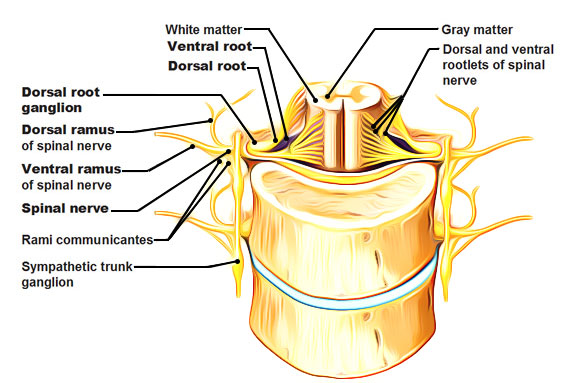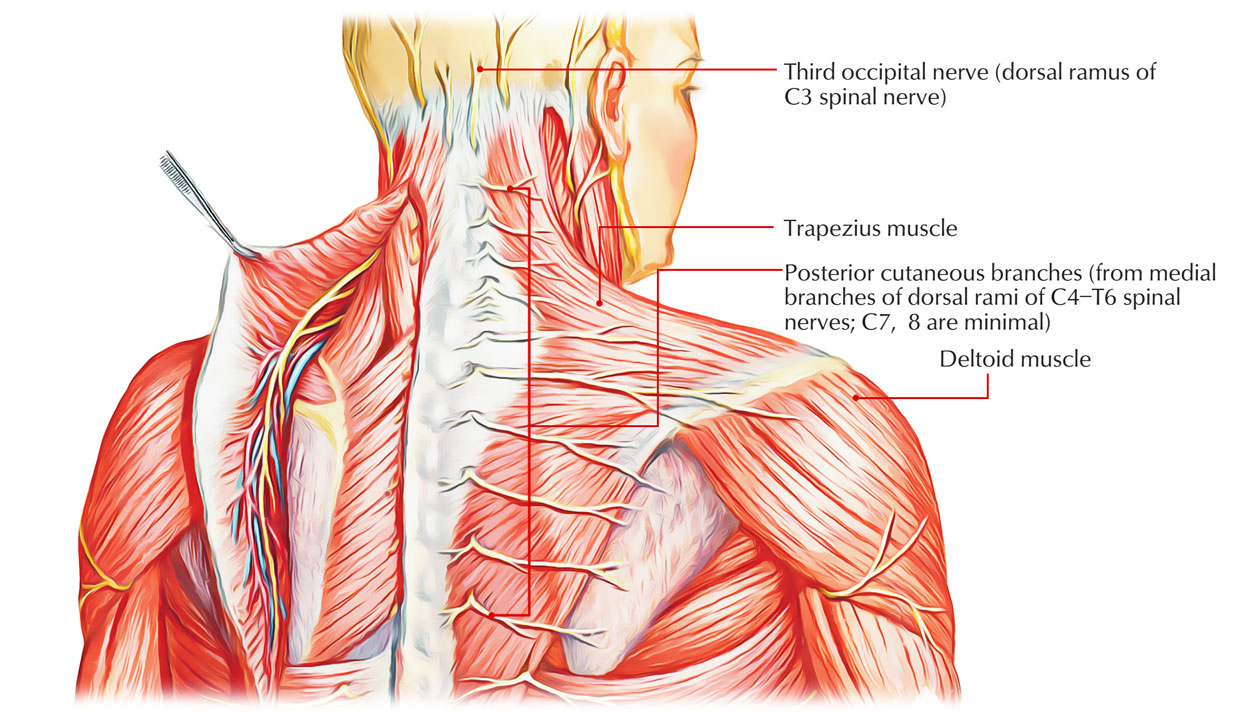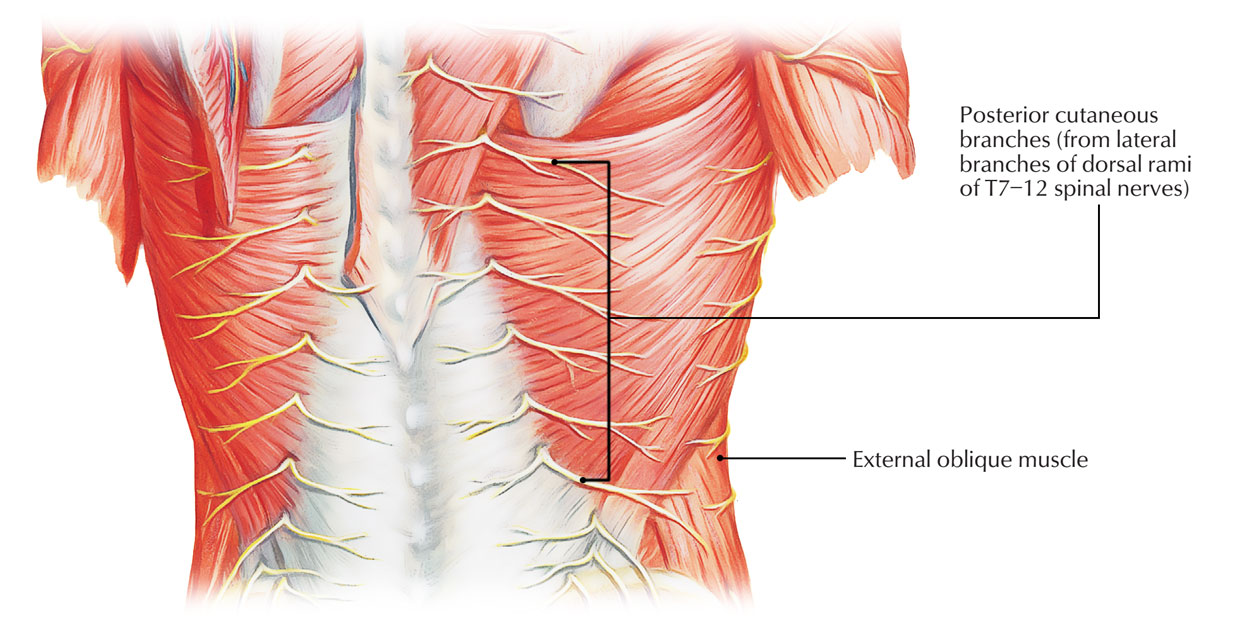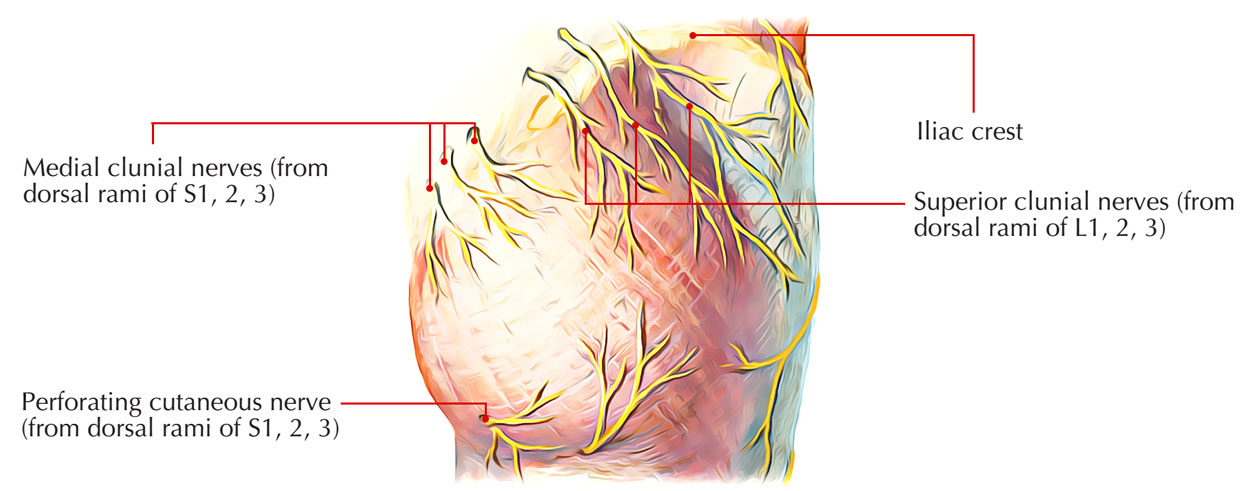31 pairs of spinal nerves are found in the human body. All spinal nerves originate from a ventral root as well as a dorsal root. The combination of many dorsal as well as ventral root filaments or rootlets forms each root. All spinal nerve almost directly split up within a large ventral ramus as well as smaller dorsal ramus.

Dorsal Rami
- The ventral rami transforms into nerves of the body like the ulnar, median, femoral, and intercostal nerves.
- The dorsal rami primarily supply the skin of the back along with the deep muscles of the back such as the erector spinae.
Dorsal or Posterior rami split into medial, intermediate and lateral divisions.
- The lateral branch supplies innervation the skin lateral to the muscle on the back as well as to the iliocostalis muscle.
- The Intermediate branch supplies the longissimus muscle as well as the spinalis muscle.
- The medial branch supplies the rest of the epiaxial derivative muscles on the back.
Functions – Innervations
Dorsal rami of spinal nerves in human anatomy
- With the exception of the first two cervical spinal nerves, when compared to the ventral rami, the dorsal rami of spinal nerves are shorter.
- With the exception of the first cervical, fourth and fifth sacral and the coccygeal nerves dorsal rami produce a medial as well as a lateral branch.
- They supply the dorsal part of the neck and torso along with the muscles, fascia, ligaments, and skin.
Cervical zone

Dorsal Rami – Cervical Zone
- With the exception of C1, a medial and lateral branch is produced by dorsal rami of the cervical nerves, both of which innervate the muscles.
- The dorsal ramus of the C1 nerve may be absent sometimes and is larger compared to the ventral ramus. It is known as the suboccipital nerve. The muscles of the suboccipital triangle and the semispinalis capitis are supplied by the suboccipital nerve.
- The greater occipital nerve is a large medial branch that is produced by C2 dorsal ramus along with a small lateral branch. The skin of the back of the scalp as far as the vertex of the skull is supplied by the greater occipital nerve. Adjoining muscles are supplied by the lateral branch.
- The C3 dorsal ramus produces a deep lateral branch that moves in the multifidus muscle as well as a superficial medial branch, a.k.a. the third occipital nerve, which innervates the skin of lower occipital zone. Sometimes the suboccipital nerve and the medial branches of the C2-C3 dorsal rami are combined in the posterior cervical zone together with nerve fiber loops in order to create the posterior cervical plexus. Also, the dorsal rami of the lower five cervical nerves split up into medial and lateral divisions.
- The medial branches of C4-C5 travel in the middle of the semispinalis capitis along with the semispinalis cervicis muscles and terminate as cutaneous branches; lateral branches reach the longissimus capitis or splenius capitis muscles.
- The dorsal rami of C7-C8 as well as occasionally C5 and C6 do not possess cutaneous branches.
- The iliocostalis cervicis, longissimus cervicis and longissimus capitis muscles are supplied by lateral branches of C6-C8 dorsal rami; the multifidus, semispinalis cervicis, and interspinalis muscles are supplied by the medial branches.
Thoracic zone

Dorsal Rami – Thoracic Zone
Near the facet joints the thoracic dorsal rami divide into medial and lateral divisions:
- After traveling through the erector spinae, the medial branches of the upper thoracic dorsal rami (T1-T6) become superficial and in order to innervate the skin reach the apexes of the spinous processes of equivalent vertebrae. Semispinalis thoracis and multifidus muscles are supplied by the medial branches of the upper thoracic dorsal rami.
- Amongst the dorsal medial cutaneous branches of T2 with the descending lateral branch of the accessory nerve, an anastomosis has been found. The lateral paravertebral muscles are innervated by the lateral branches of the dorsal rami.
From T7 to L1 (or L2), this pattern is reversed:
- At the apex of the spinous processes, the medial branches of these nerves end up supplying the multifidus and longissimus thoracis muscles and near the midline innervating the skin irregularly.
- The lateral branches run through, and supply the longissimus thoracis and the iliocostalis muscles, and also give off cutaneous branches that pierce the Serratus posterior inferior and Latissimus dorsi muscles.
- The lateral branch of the dorsal ramus of T12 travels above the iliac crest towards the ventral part of the gluteal skin.
Lumbar zone
The lumbar dorsal rami originate perpendicularly from the spinal nerves and divide within medial as well as lateral branches immediately after their departure from the intervertebral foramina. The multifidi and erector spinae muscles are supplied by the medial and lateral branches, respectively.
- Small branches are distributed towards the skin of the sacral zone by the medial branches of the lower three lumbar segments.
- Cutaneous nerves are produced by the lateral branches of the upper three lumbar dorsal spinal rami that travel downwards in order to supply the skin of the buttock.
The L1-L4 dorsal rami create three branches – medial, lateral, and intermediate, which are, respectively, distributed towards the multifidi, iliocostalis and longissimus muscles.
At L1-L3 the lateral and intermediate divisions may emerge in an alternative manner from a short common stem, while the L4 dorsal ramus regularly creates three divisions. The L5 dorsal ramus creates only a medial as well as an intermediate branch and is much longer compared to the other lumbar dorsal rami.
Sacral zone

Dorsal Rami – Sacral Zone
- The dorsal sacral foramina give origin to the sacral dorsal rami. Under the multifudi the upper three dorsal sacral rami divide into medial and lateral branches.
- The multifidi are innervated by the medial branches.
- In order to create the posterior sacrococcygeal plexus a.k.a. posterior sacral nerve plexus lateral branches of S1-S3, S4 and L5 dorsal rami anastomose with each other.
- In order to create a second series of loops more branches arise from this plexus under the gluteus maximus muscle.
- In order to supply the skin over the lower part of the buttock, the nerves originating from here penetrate gluteus maximus muscle.
- The dorsal rami of S4-S5 are located under the multifidi and are small in size. In order to form loops on the back of the sacrum and in order to supply the skin over the coccyx, they combine with each other and with the posterior division of the coccygeal nerve.
Coccygeal zone
The dorsal ramus of the coccygeal nerve is small and does not create branches. For supplying the skin over the dorsal surface of the coccyx, it connects with a branch from S5.

 (50 votes, average: 4.60 out of 5)
(50 votes, average: 4.60 out of 5)